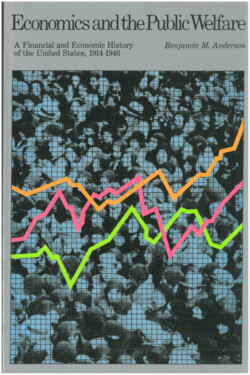Читать книгу Economics and the Public Welfare - Benjamin M. Anderson - Страница 5
На сайте Литреса книга снята с продажи.
Оглавление[print edition page 5]
Contents
| Foreword, by Arthur Kemp | |
| Preface | |
| PART I: WORLD WAR I | |
| CHAPTER | |
| 1. | The Prewar World, 1913 |
| 2. | The Outbreak of the War in 1914 |
| 3. | The War Prosperity |
| 4. | Our War Economic Policy |
| 5. | The Federal Reserve System, 1914-18 |
| PART II: THE POSTWAR BOOM, CRISIS, AND REVIVAL, 1919-23 | |
| 6. | The Postwar Boom, 1919-20 |
| 7. | The Causes of the Crisis of 1920 |
| 8. | The Crisis—1920-21 |
| 9. | The Rapid Revival—August 1921 to March 1923 |
| 10. | The Government’s Contribution to the Revival, 1921-23 |
| 11. | The Money Market, 1920-23—Renewed Bank Expansion |
| 12. | Our Foreign Policy, 1919-24 |
| 13. | Germany, 1918-24 |
| 14. | France, 1918-24 |
| 15. | The Dawes Plan |
| PART III: THE FIRST PHASE OF THE NEW DEAL, 1924-32 | |
| 16. | Depression and Rally of 1924—The Beginning of the New Deal |
| 17. | Money, Bank Credit, and Capital |
| 18. | The Extent of Bank Expansion, 1922-28 |
| [print edition page 6] | |
| 19. | The Causes of and the Responsibility for the Excess Reserves |
| 20. | Germany, 1924-28 |
| 21. | France, 1925-26 |
| 22. | Great Britain, 1925-27 |
| 23. | The De Facto Stabilization of the Franc, and the Gold Exchange Standard |
| 24. | The Consequences of the Cheap Money Policy in the United States Down to the Summer of 1927 |
| 25. | The Conference of Governors and the Intensification of Cheap Money, 1927 |
| 26. | The Stock Market Boom, 1927-29 |
| 27. | Mob Mind in 1928-29 |
| 28. | The Effect on Europe of Tight Money in the United States in 1929 |
| 29. | The “New Era,” and the Precautions of the Commercial Banks in New York |
| 30. | The Stock Market Crash of 1929 |
| 31. | The New Deal in 1929-30 |
| 32. | Late 1930—Hitler Gains; Bank of United States Crashes |
| 33. | The Tragic Year—1931 |
| 34. | 1931 Continued—England’s Abandonment of the Gold Standard |
| 35. | The Year 1931 Continued—The First Foreign Run on the Gold of the United States |
| 36. | The Year 1932 |
| 37. | The Upturn in the Summer of 1932—Five Favorable Developments |
| 38. | The Impact of Politics on the 1932 Revival |
| 39. | The Banking Holiday |
| 40. | The Intergovernmental Debts |
| PART IV: THE NEW DEAL IN MATURITY, 1933-39 | |
| 41. | “My Father Also Chastised You with Whips, but I Will Chastise You with Scorpions” |
| 42. | The Reopening of the Banks |
| 43. | The Mortality Among Small Banks |
| 44. | Branch Banking Versus Unit Banking |
| 45. | Roosevelt’s Abandonment of the Gold Standard |
| 46. | The Banking Act of 1933—Extreme Reform Bill, Not New Deal Measure |
| 47. | Contradictory Policies |
| 48. | The National Industrial Recovery Act |
| [print edition page 7] | |
| 49. | The London Economic Conference, 1933 |
| 50. | The Strong Business Rally, March-July 1933—Turns Downward with NRA |
| 51. | More Money Magic—The Gold-Buying Program |
| 52. | The Gold Reserve Act of 1934 |
| 53. | The Spending Program |
| 54. | The Silver Legislation of 1934 |
| 55. | Government Confusion, Government Hostility, and Private Enterprise |
| 56. | Supreme Court Decision on Gold Clauses, February 1935 |
| 57. | First Successful Resistance to New Deal—Banking Act of 1935 |
| 58. | Taxation Under the New Deal—The Redistribution of Wealth |
| 59. | The Undistributed Profits Tax of 1936 |
| 60. | Digression on Keynes |
| 61. | Gold, Excess Reserves, and Money Rates, 1934-41 |
| 62. | Gold Remains Standard of Value |
| 63. | The British Equalization Account, the American Stabilization Fund, and the American Sterilization Fund |
| 64. | The Tyranny of Gold |
| 65. | Governmental Coercion and the Value of Money |
| 66. | The Business Rally of 1935-37 and the Major Crisis of 1937 |
| 67. | The Causes of the Crisis of 1937 |
| 68. | The Stock Market Crash of 1937—A Major Cause of Business Crisis |
| 69. | A Verdict on the SEC |
| 70. | The Severe Depression, 1937-38, and the Mild Rally, 1938-39 |
| 71. | The Turn in the Political Tide, 1938 |
| 72. | International Political Relations in the Decade of the Thirties |
| 73. | The Effect of Government Economic Planning upon Employment and the Utilization of Our National Productive Powers |
| 74. | Alternative Explanations of the Great Depression of 1930-39 |
| PART V: WORLD WAR II | |
| 75. | The Outbreak of World War II |
| 76. | Our War Economic Policy |
| [print edition page 8] | |
| 77. | War Taxation and Expenditures |
| 78. | Government Borrowing in World War II |
| 79. | Price Fixing in World War II |
| 80. | Government Versus Private Financing of War Production in World War II |
| 81. | Lend-Lease, Bretton Woods, and the British Loan—England’s Postwar Position |
| Index |
